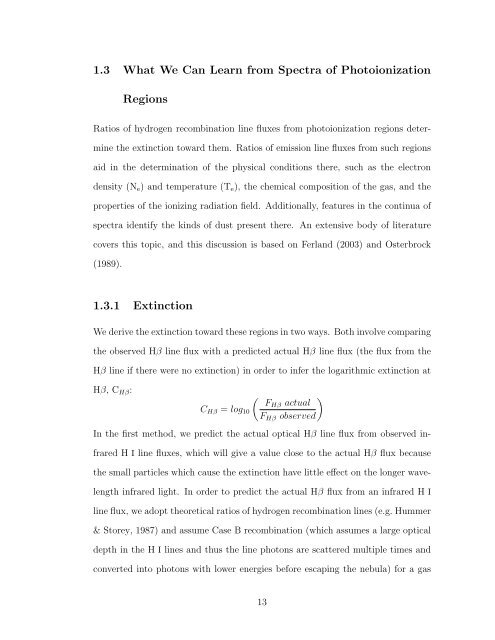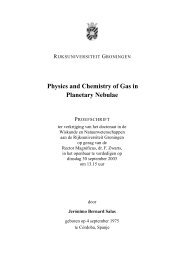TRACING ABUNDANCES IN GALAXIES WITH THE SPITZER ...
TRACING ABUNDANCES IN GALAXIES WITH THE SPITZER ...
TRACING ABUNDANCES IN GALAXIES WITH THE SPITZER ...
You also want an ePaper? Increase the reach of your titles
YUMPU automatically turns print PDFs into web optimized ePapers that Google loves.
1.3 What We Can Learn from Spectra of Photoionization<br />
Regions<br />
Ratios of hydrogen recombination line fluxes from photoionization regions deter-<br />
mine the extinction toward them. Ratios of emission line fluxes from such regions<br />
aid in the determination of the physical conditions there, such as the electron<br />
density (Ne) and temperature (Te), the chemical composition of the gas, and the<br />
properties of the ionizing radiation field. Additionally, features in the continua of<br />
spectra identify the kinds of dust present there. An extensive body of literature<br />
covers this topic, and this discussion is based on Ferland (2003) and Osterbrock<br />
(1989).<br />
1.3.1 Extinction<br />
We derive the extinction toward these regions in two ways. Both involve comparing<br />
the observed Hβ line flux with a predicted actual Hβ line flux (the flux from the<br />
Hβ line if there were no extinction) in order to infer the logarithmic extinction at<br />
Hβ, CHβ:<br />
CHβ = log10<br />
� �<br />
FHβ actual<br />
FHβ observed<br />
In the first method, we predict the actual optical Hβ line flux from observed in-<br />
frared H I line fluxes, which will give a value close to the actual Hβ flux because<br />
the small particles which cause the extinction have little effect on the longer wave-<br />
length infrared light. In order to predict the actual Hβ flux from an infrared H I<br />
line flux, we adopt theoretical ratios of hydrogen recombination lines (e.g. Hummer<br />
& Storey, 1987) and assume Case B recombination (which assumes a large optical<br />
depth in the H I lines and thus the line photons are scattered multiple times and<br />
converted into photons with lower energies before escaping the nebula) for a gas<br />
13













